Understanding Real Ruby Prices: What You Need to Know
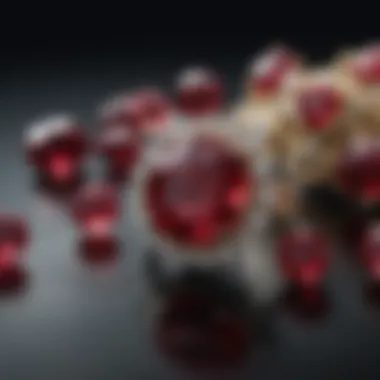
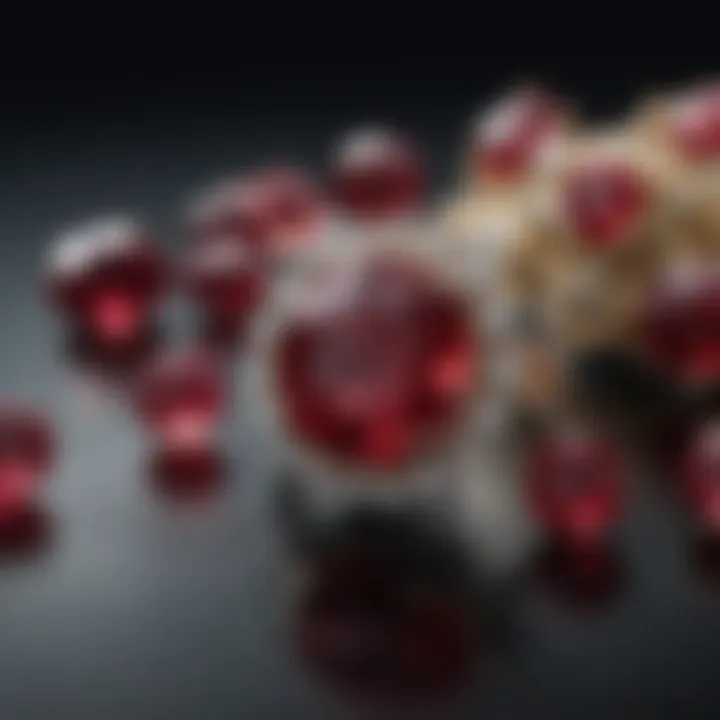
Intro
The price of real ruby is a subject of both fascination and complexity. Understanding this gemstone requires more than just a glance at its surface beauty. Various factors contribute to how rubies are valued in the market.
This article aims to unravel these intricacies, providing a detailed look at the elements that shape the pricing of rubies. From types and quality to market trends and grading systems, every aspect plays a crucial role. Additionally, we will cover the rarity of rubies and the importance of origin, which can greatly affect their perceived value.
For enthusiasts, collectors, and consumers alike, gaining insights into the ruby market can empower more informed decisions. As we embark on this comprehensive analysis, let us begin with a thorough overview of the gemstone itself.
Prelims to Ruby Prices
Understanding the price of real rubies is crucial for anyone involved in the gemstone market, whether as a collector, buyer, or seller. The complexities surrounding ruby pricing are influenced by various factors that require a thorough examination.
First, it’s essential to recognize that rubies have a unique status in the gemstone hierarchy. The blend of their aesthetic appeal, rarity, and cultural significance elevates not only their beauty but also their investment potential. Beyond the allure of their color, the price of rubies can vary significantly based on their characteristics, which we will delve into in subsequent sections.
Furthermore, this article is dedicated to breaking down the intricate aspects that affect ruby prices, such as their color quality, clarity levels, and the impact of carat weight. These elements play a significant role in determining the overall market value of rubies, and understanding them can empower consumers to make informed decisions.
The intricacies of the ruby market also extend to the geographical origins of the stones. Different regions produce rubies with varying qualities, which contributes to fluctuating prices. For example, Burmese rubies are often regarded as superior compared to those from other regions, influencing both desirability and market rates.
In addition, knowledge of grading systems is essential. Various organizations, like the Gemological Institute of America (GIA), provide classifications that help standardize the evaluation of rubies. Learning about these grades can help mitigate the risk of making poor investments due to misrepresented qualities.
The benefits of understanding ruby prices extend beyond mere acquisition; they contribute to a broader comprehension of market trends and economic factors that may influence the value of rubies. As gemstone enthusiasts navigate their buying or selling journeys, insight into these dynamics fosters intelligent decision-making.
"The right knowledge can turn a smart purchase into a wise investment in rubies."
Discerning the constant shifts in the ruby market and grasping the various elements elevating or diminishing the price of rubies can enhance one’s strategy in dealing with such precious stones. The understanding of ruby pricing, therefore, serves not only to clarify complexities but also as a guide towards maximizing value, both emotionally and financially.
The Nature of Rubies
Understanding the true nature of rubies is crucial for both collectors and buyers. This section aims to break down the complexities of rubies, including their scientific background and different types. The knowledge of how rubies are formed, their chemical composition, and classification can significantly impact pricing and desirability in the market.
Scientific Background
Rubies are a variety of the mineral corundum, composed mainly of aluminum oxide. The presence of chromium gives rubies their characteristic red color. This unique combination of elements creates a stone that is not only beautiful but also one of the hardest gemstones available, ranking 9 on the Mohs scale of hardness. The formation of rubies occurs deep within the Earth's crust under heat and pressure, which makes them relatively rare. Each ruby bears unique qualities related to their formation environment, contributing to the variance in price, appeal, and grading.
Types of Rubies
The classification of rubies is essential for understanding their value. Each type of ruby has its unique characteristics that influence its market price and desirability.
Natural Rubies
Natural rubies are formed entirely by natural geological processes. Their significant aspect is their authenticity, as they have not undergone any human intervention. This characteristic generally makes them more valuable. Natural rubies can show inclusions, which may affect clarity but can also serve as proof of their origin. Collectors appreciate these stones for their rarity and historic significance. The color and quality levels of natural rubies make them a popular choice for high-end jewelry.
Treatment of Rubies
Many rubies available on the market today undergo treatments to enhance their color and clarity. The most common treatments include heating and filling fractures with substances like glass or resin. This process aims to improve the stone's appearance while still preserving its classification as a ruby. Treated rubies can be a more affordable option for consumers, but their market value is typically lower than that of natural stones. Knowing the treatment process and its implications allows buyers to make informed purchasing decisions.
Lab-Created Rubies
Lab-created rubies are produced using artificial processes that mimic natural conditions. One key characteristic of these rubies is their perfect clarity and color. As a result, they can be less expensive than natural rubies. While they possess the same chemical and optical properties, their production method often causes concern among buyers looking for authenticity. Lab-created rubies can be an attractive option for those looking for budget-friendly alternatives without compromising on appearance. However, their resale value is usually lower, which is an important consideration for those interested in investment.
Factors Influencing Ruby Price
Understanding the factors that influence the price of rubies is essential for buyers, collectors, and enthusiasts. Rubies are not merely gemstones; they carry significant aesthetic value, cultural importance, and market dynamics. Various elements play a role in determining their worth. Some factors are intrinsic to the gemstones themselves, while others depend on market trends and consumer demand.
The primary factors include color, clarity, cut, and carat weight. Each of these contributes uniquely to the overall price. The interplay of these elements can lead to unique pricing profiles for different rubies in the market.
Color
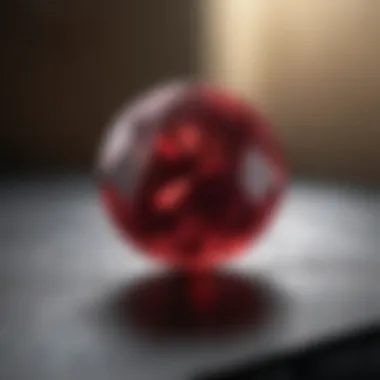
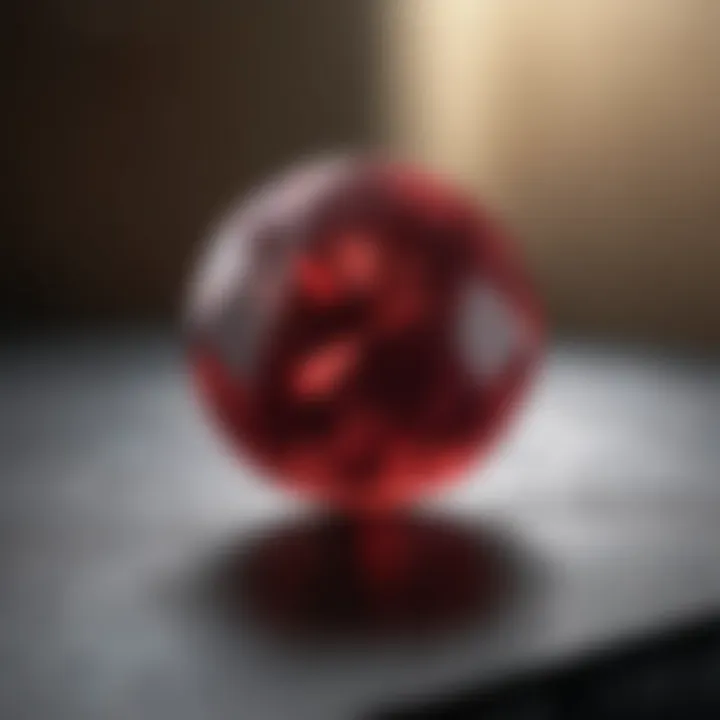
Color is often regarded as the most crucial factor affecting ruby prices. The hue, tone, and saturation can greatly impact value.
Shade and Saturation
When it comes to rubies, the shade refers to the basic color. Saturation deals with the intensity or vividness of that color. Generally, intense red hues with high saturation are the most sought after. Deep red rubies, known as "pigeon blood" rubies, tend to fetch premium prices. This characteristic not only elevates the stone's beauty but also increases its desirability.
High saturation results in vibrant colors that are visually appealing. Buyers frequently seek these stones because they exude luxury and sophistication. Shadows or fading in color can detract from the beauty and, therefore, the value of the ruby.
Color Origin
The origin of a ruby's color can also materially affect its price. Origin indicates where the ruby is from, with certain regions known for producing superior stones. For instance, Burmese rubies are often praised for their rich red tones, while Thai rubies may present darker shades.
The geographical location contributes a key characteristic, as specific mining areas yield distinct ruby qualities. The tradition, history, and quality control associated with these origins enhance their marketplace perception. Buyers often pay more for rubies from regions with a storied past of producing exceptional gems, making the understanding of color origin essential in pricing considerations.
Clarity
Clarity signifies how free a ruby is from inclusions and blemishes. A clear ruby generally holds a higher value compared to those with visible imperfections. Natural rubies often have some inclusions, but fewer inclusions generally correlate with a higher price. Clarity affects not just aesthetic qualities but also a buyer's perception of the gemstone's overall quality.
Cut
The cut of a ruby affects its overall appearance and brilliance. A well-cut ruby will reflect light better, enhancing its visual appeal. This factor also influences the stone’s price. Cut styles can vary, but the ultimate goal is to maximize the stone's features, including clarity and color. A poor cut can greatly diminish the value, regardless of the stone's other attributes.
Carat Weight
Carat weight is another significant factor. Higher carat weights usually lead to higher prices, as larger stones are rarer. However, this does not mean that all larger rubies are automatically valued higher. The overall quality, including the previously mentioned factors, is also crucial in establishing price. Understanding carat weight helps buyers gauge the potential investment value in terms of size and rarity in the market.
Each of these factors work in harmony to determine the final market price of a ruby. It is essential for gem enthusiasts and potential buyers to thoroughly consider these components when evaluating or investing in rubies.
The Role of Origin
The origin of rubies plays a crucial part in determining their value and desirability. Each source of ruby mining contributes its own unique characteristics that can affect color, clarity, and size. Understanding the importance of origin goes beyond mere geography; it encompasses historical significance, local mining practices, and market perception. Knowledge of where a ruby comes from allows buyers to make more informed decisions, and it influences the gemstone's market dynamics.
Geographic Impact
Burmese Rubies
Burmese rubies are renowned for their exceptional color and quality. They often exhibit a rich, deep red hue with strong fluorescence, a factor that enhances their luster. Burmese rubies typically show fewer inclusions than other types, which adds to their overall appeal. The key characteristic of Burmese rubies is their high saturation level, which makes them particularly sought after among collectors and enthusiasts.
Their unique feature lies in the specific geology of the region around Mogok; the minerals there create the perfect conditions for producing high-quality rubies. However, due to political and economic challenges, availability can fluctuate, influencing their pricing day-to-day.
Thai Rubies
Thai rubies have a different profile compared to their Burmese counterparts. Predominantly showing a more brownish red color, these rubies have been traditionally less valued. However, they still hold significance due to their widespread availability and more affordable price points. The key characteristic of Thai rubies is their larger sizes, as Thai mining operations often yield bigger stones.
The unique feature of these rubies is their extensive range, from commercial-grade to higher-end options. One disadvantage to consider is the processing and treatments often involved, which can affect a ruby's natural integrity. Buyers should take care in verifying the treatment status of Thai rubies before purchasing.
East African Rubies
East African rubies have gained attention in recent years for their unique colors and properties. Found in countries like Mozambique, these rubies can exhibit vibrant reds with excellent clarity. Their key characteristic is their accessibility; they are often cheaper than rubies from more established regions.
One unique feature of East African rubies is their variability, which means they can range widely in appearance. While some display attractive saturation and brightness, others may have lesser quality due to inclusions or color zoning. Buyers can benefit from this variety by finding rubies that fit specific styles and preferences at differing price ranges.
Historical Significance
The historical significance of rubies and their origins underscores the cultural narratives tied to these gemstones. Rubies sourced from Burma have often been equated with royal lineage and high social status. Their presence in various historical artifacts often enhances their appeal today. On the other hand, the newer market for East African rubies represents an evolution in mining practices.
Understanding these factors guide potential buyers in not only assessing the physical aspects of a ruby but also its narrative strength. Cultivating knowledge around the role of origin helps consumers appreciate the full spectrum that real rubies offer.
"A ruby’s origin will often dictate its price, quality, and desirability, making knowledge of this aspect essential for any serious collector."
This comprehensive view of rubies' origins provides essential insight for enthusiasts and collectors alike.
Market Dynamics
Market dynamics play a crucial role in determining the price of real rubies. This section will explore how various factors interact to influence pricing, starting from the basic laws of supply and demand to broader economic influences that affect the ruby market.
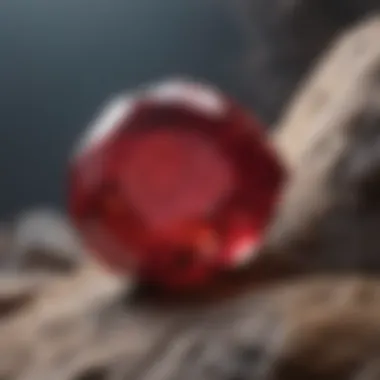
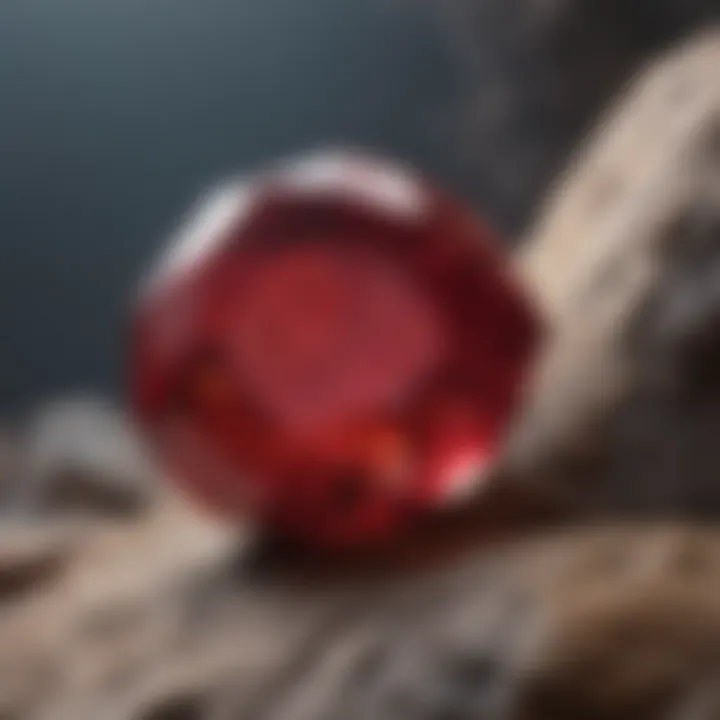
Supply and Demand
In any market, supply and demand are key elements dictating prices. Rubies are finite in nature; their mining and production pathways are constrained by the geographical locations where they can be extracted.
- Scarcity: As rubies are rare, their supply is limited. Countries like Myanmar, Thailand, and some regions of East Africa contribute significantly to the ruby supply. This geographic limitation creates a natural scarcity, adding pressure to prices when demand increases.
- Consumer Demand: The desire for high-quality rubies has grown among collectors, jewelry designers, and investors. This increased demand at times leads to price surges, particularly for high-grade rubies. Factors such as trends in jewelry design and marketing strategies also impact consumer behaviors.
- Market Fluctuations: Prices can fluctuate based on economic conditions. For instance, during economic booms, more buyers may seek out rubies as luxury items. Conversely, economic downturns can lead to reduced spending and lower demand for gemstones.
When these forces of supply and demand meet, they can cause the pricing of rubies to shift, thus affecting the market overall. The balance between these two forces can be complex, influenced by both internal and external conditions.
Economic Influences
Economic conditions play a vital part in ruby pricing dynamics. Various facets of the economy can directly or indirectly impact the ruby market.
- Global Economy: A robust global economy strengthens consumer confidence and increases luxury spending. When the economy thrives, individuals are more likely to invest in precious gemstones like rubies. In contrast, recessions tend to make consumers cautious, often delaying purchases of non-essential items.
- Import/export Regulations: Trade policies and tariffs can alter market access for rubies. Countries with strict import regulations may complicate the trade of rubies, leading to supply shortages that ultimately push prices higher. Conversely, favorable trade deals can enhance access, stabilizing prices.
- Currency Fluctuations: The strength or weakness of currencies can affect pricing for international buyers. For example, when the US dollar is strong, foreign buyers may find rubies more expensive, leading to changes in demand and market pricing.
Grading Rubies
Grading rubies is a crucial aspect of understanding their value and helps buyers make informed decisions. Different grading systems exist, each with unique characteristics and recognition. This section will explore the significance of ruby grading and the standards that govern the classification of these gemstones. Knowing how rubies are graded provides insight into pricing, quality, and overall market value.
GIA Grading System
The Gemological Institute of America (GIA) is renowned for its rigorous grading standards. The GIA grading system evaluates rubies based on the four Cs: color, clarity, cut, and carat weight. Color is typically the most important factor since it significantly influences the stone's overall appeal and price. With GIA, color grading involves assessing the hue, tone, and saturation.
Moreover, GIA considers clarity by examining the stone for inclusions and blemishes. The cut affects how light interacts with the ruby, impacting brilliance. Carat weight is straightforward but equally crucial, as larger carat sizes fetch higher prices.
The GIA's credibility and detailed grading reports instill confidence for buyers and traders. It has a global recognition and is often sought for accurate assessments. However, GIA services can be more expensive than other options, which may be a factor for some buyers.
Other Certification Bodies
While GIA is highly regarded, other organizations also offer certification for rubies. Each has its approach and benefits, providing additional choices for consumers.
AGL
The American Gemological Laboratories (AGL) is another notable certifying entity. AGL focuses primarily on the identification and treatment of gemstones, including rubies. It provides detailed reports that explain the gem’s origin and enhancement treatments, which are critical in determining value.
One key characteristic of AGL is its emphasis on transparency. AGL's reports often include a fluorescence assessment, which is less common in other systems. This aspect benefits buyers who want a comprehensive understanding of their gems. While AGL's reports may not carry the same weight globally as GIA, they are respected in the industry and preferred by certain collectors and dealers.
EGL
The European Gemological Laboratory (EGL) is another recognized organization. EGL provides grading services that evaluate the same attributes as GIA but often at a lower cost. A notable feature of EGL is its accessibility to a broader audience, making it an attractive choice for those new to the market.
However, EGL has faced criticism regarding consistency in grading. Some buyers might find the flexibility of grading varies significantly between different EGL locations. Thus, while EGL may present a more budget-friendly option, prospective buyers should remain cautious about relying solely on EGL reports when making high-stakes purchases.
"Understanding various grading systems empowers buyers to assess value better and avoid potential pitfalls."
The comparison of these grading bodies illustrates the essential information buyers must consider when exploring rubies. GIA stands for unmatched rigor, while AGL and EGL provide unique perspectives that cater to specific needs. Buyers benefit from understanding these systems, as they significantly influence the pricing and desirability of rubies.
Investment Potential
In recent years, real rubies have gained recognition not just as beautiful gemstones, but also as worthy investments. This section will explore the investment potential of rubies, emphasizing the significance and considerations for collectors and investors alike.
Investing in rubies can be attractive for several reasons. Firstly, the rarity of high-quality rubies is a notable factor that often contributes to their increasing value over time. Unlike more common gemstones, exquisite rubies are limited in supply due to their specific geological conditions required for formation. Thus, investors can find potential for substantial returns as market demand continues to rise but supply remains restricted.
When considering investing in rubies, potential buyers must analyze various elements. The gemstone’s color, clarity, cut, and carat weight are critical indicators of quality. For instance, vibrant reds with high saturation are generally more sought after. Additionally, clarity plays a significant role; stones that are eye-clean are more desirable. Also, a good cut enhances the ruby's brilliance and helps maximize its market value.
Another important aspect in the realm of investment potential is the certification of rubies by reputable grading bodies. Understanding the grading system, such as the GIA grading standards, assists buyers in making confident decisions about authenticity and quality.
Investors should be mindful of the following considerations:
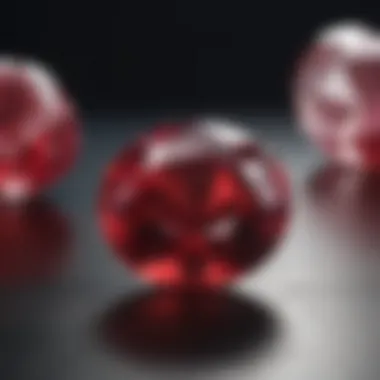
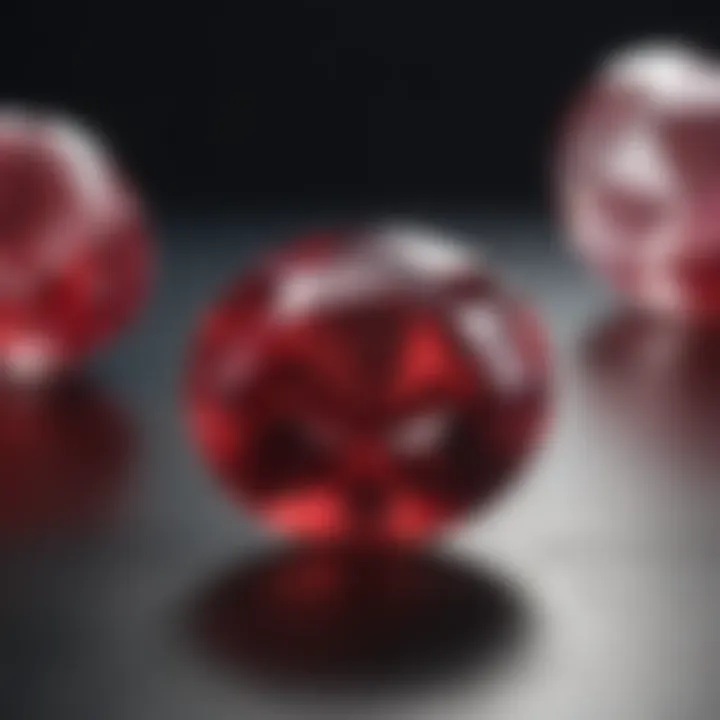
- Stay informed about market trends and pricing fluctuations.
- Investigate the background and origin of the ruby, as this can impact value significantly.
- Seek expert opinions or consult with qualified jewelers before making significant purchases.
Overall, the investment potential of rubies lies in their beauty, rarity, and finite nature. Many industry experts believe that precious gemstones like rubies are more than mere adornments; they symbolize a store of value. As new generations include gemstones as part of their investment portfolios, this trend may only grow stronger.
Buying Strategy
A well-devised buying strategy is fundamental for anyone looking to invest in rubies. Such a strategy should incorporate thorough research, personal preferences, and market conditions.
To build an effective buying strategy, consider the following elements:
- Define your budget: Identify how much you are willing to invest without compromising your financial stability.
- Research the market: Stay updated with prices through gem shows, auction results, and online platforms to understand current trends.
- Select reputable sources: Purchase rubies only from certified dealers or established auction houses to ensure authenticity.
It is also helpful to build relationships with reliable jewelers. These contacts can provide insights into upcoming trends, potential investments, and opportunities to acquire high-quality stones.
Long-Term Value
The long-term value of rubies can be significant, especially for well-chosen pieces. Historical data supports the notion that fine gemstones often appreciate in value over time. Unlike stocks or bonds, which can fluctuate dramatically, the intrinsic value of gemstones like rubies tends to stabilize and appreciate over decades.
Several factors will likely aid in maintaining or increasing the long-term value of rubies:
- Cultural significance: Rubies have been treasured across various cultures, adding to their appeal as valuable assets.
- Branding and designer influence: Association with renowned jewelry designers can enhance the value of a ruby and contribute to its investment potential.
- Market viability: As the demand increases in emerging markets, a diverse buyer pool will help maintain value.
Ruby Care and Maintenance
Rubies are not only cherished for their beauty but also valued for their durability. However, proper care and maintenance are essential to preserve their luster and structural integrity. Understanding how to maintain rubies is necessary for any collector or jewelry designer. By investing time in care and maintenance, one can significantly enhance the life and beauty of these gemstones.
Cleaning Techniques
Cleaning rubies is straightforward yet important for maintaining their shine. Here are some effective approaches for cleaning:
- Soap and Water Method: Mix a few drops of mild dish soap in warm water. Use a soft brush, such as a toothbrush, to gently scrub the ruby. Avoid harsh chemicals that can damage the stone.
- Ultrasonic Cleaners: For a deeper clean, ultrasonic cleaners can be used. However, caution is necessary. Ensure that your ruby is untreated since some treatments may be affected by ultrasonic cleaning.
- Professional Cleaning: For valuable or antique rubies, seeking professional cleaning services is wise. They have the tools and expertise to handle your gemstones safely.
Tip: Always rinse your rubies in clean water after washing to eliminate any soap residue.
Storage Tips
Proper storage is vital in safeguarding rubies from scratches and damage. Here are guidelines to follow:
- Use Soft Cloth Pouches: Store rubies in soft cloth bags or pouches. This prevents contact with other jewelry pieces that may scratch the surface.
- Separate Storage: Avoid placing rubies together with harder gemstones. This separation minimizes the risk of physical damage.
- Ideal Environment: Keep rubies away from extreme temperatures and humidity. A cool, dry environment is best to prevent any impact on the stone's quality.
In summary, maintaining the clarity and beauty of rubies requires appropriate cleaning and storing practices. Care and attention to detail will ensure that these precious stones retain their value and beauty over time.
The End and Future Trends
Understanding the price of real rubies is an ongoing journey. The ruby market reflects broader economic conditions and cultural shifts. Thus, staying informed about future trends is crucial for buyers and collectors. Below, we outline some pertinent elements that signal what may lie ahead for ruby prices.
Emerging Markets
Emerging markets are a significant focal point in the discourse on ruby pricing. Countries such as China and India have shown an increasing demand for gemstones. As the middle class expands, more people aspire to own luxury items, including rubies. This shift can create a boost in global prices.
Consumer behavior also plays a role. As awareness of quality and rarity increases, buyers are becoming more discerning. They value natural rubies over treated or lab-created options. This trend can lead to sharper price discrepancies between high-quality natural rubies and their counterparts.
Furthermore, localized mining activities in regions like Africa are starting to gain traction. This can diversify the supply, potentially affecting prices. Investors and collectors need to observe these emerging markets carefully, as they can redefine the overall landscape of ruby valuation.
Technological Advancements in Gemstone Evaluation
Technological innovations continue to impact the gemstone industry. Advances in gemological equipment allow for more precise evaluations of rubies. For instance, spectroscopy and photoluminescence imaging can reveal important information about a ruby’s origin and treatment history.
Moreover, blockchain technology is making its way into the gemstone sector. This can help in establishing authenticity and provenance. Such advancements not only provide reassurance to buyers but also impact pricing structures. With better traceability, the value perception of rubies may shift, making certified high-quality rubies more sought after.
We can conclude that keeping an eye on these trends is essential for anyone interested in the ruby market. As new markets emerge and technologies evolve, the future landscape of ruby prices will be shaped, offering both challenges and opportunities for collectors and investors alike.
"In the intricate world of rubies, knowledge of market dynamics and technological advancements guides informed decisions."
Being well-informed is key in this evolving market. Understanding these trends can empower buyers to make educated choices, ensuring they maximize their investments in this exquisite gemstone.



